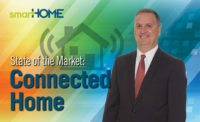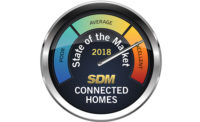A connected home cannot happen without the protocol or language to make everything work together. From proprietary protocols from specific manufacturers to open standards such as Zigbee and Z-Wave, to next-generation offerings such as Google Thread/Weave and Apple’s Home Kit, the field keeps growing and will likely have to narrow at some point. The question is will there be two or more equally popular standards such as Apple and Android or will one push out another as VHS did with Betamax? And does it even matter?
“There is likely more market and technological consolidation coming, because devices have to work together more smoothly to truly connect,” says Napco’s Judy Jones-Shand. “Disparate, closed and proprietary ecosystems will only stave off the mass consumer adoption needed to make the connected home a real success.”
Within the security industry, Z-Wave is the predominant ecosystem, although Wi-Fi is still the most popular communications standard, with 34 percent of companies supporting it, according to IHS. Z-Wave followed with 18 percent, and of the 410 companies surveyed who actively promote smart home services, more than half (228) supported more than one protocol.
“Z-Wave is an open protocol and a lot of manufacturers have embedded that in their products,” says Kris Kaymanesh of Sight and Sound. “Zigbee is somewhat more closed. A very simple comparison is Zigbee is more like Apple and Z-Wave is more or less like Android. Each has its own advantages and disadvantages. Zigbee is very controlled so there are not as many products and the cost is higher. But we have fewer issues with compatibility. Z-Wave is open, but how they decipher the communication varies from one to the other so there are a lot more issues and complex hand-offs, and it is not quite as smooth.”
Dave Mayne of Resolution Products sees a big potential with Thread. “Zigbee is widely used by the cable industry. I really like Thread, which is based on what Zigbee has to offer but uses more IP addressing. It is more like what all our connected devices speak to and for that reason I believe it will gain broad adoption.”
However, Mayne adds that whichever protocol or protocols “win,” the effect may be negligible in the end. “Technology will be selected based on how well it works and the total cost of ownership. If Thread proves to be lower cost, the industry will adopt that.”
Alarm.com’s Jay Kenny says in the end that standards may not actually matter that much. “Google is promoting one; Apple will be promoting another. The dream is to have a single [protocol]. But we are able to obscure a lot of that complexity from the end user. We support Z-Wave, Zigbee, direct to cloud over Wi-Fi or IP, cloud-to-cloud. We believe we can manage the complexity by making everything work together at the cloud level and as soon as something becomes more of a standard we can easily adopt it.”
Vivint’s Colby Winegar says his company is agnostic to technology, working with several different protocols. “If Thread comes along and works, we are happy to adopt that and add it to our panel.”
Icontrol’s Greg Roberts similarly is not concerned about protocols. “I think it is a land grab right now, with several protocols taking advantage of the momentum in the marketplace. But every one of them is in a position to switch gears if they need to. We don’t believe there will ever be one standard because the use cases for the smart home are so diverse that one standard cannot accommodate everything. The standards for a Wi-Fi camera are very different from those of a lamp module.”
The consumer doesn’t really care, says Blake Deal of Lutron Electronics Company. “The reason it doesn’t matter is what does the homeowner want? As a consumer do you care about the standard? No. You just want it to work.”
But others see too many protocols as a potential negative to the consumer. “There are still a lot of islands of ecosystems that don’t talk to each other and that will be true for a while,” says Ryan Petty of ADT. “That will drive some concern and angst in the consumer market. ‘Do I buy this thing? Will it talk to my other thing?’”
However, Petty adds that it can be an advantage for the curated security ecosystems that are designed to do just that. “ADT has been a big adopter of Z-Wave. We enforced interoperability of devices. This thing works because we have put a lot of effort into making it work. I don’t see things getting simpler over the next few years. The only way it resolves is in the cloud or over the Internet where you talk there.”







